
A menagerie is a collection of captive animals, frequently exotic, kept for display; or the place where such a collection is kept, a precursor to the modern zoo or zoological garden.

Sir Paul Patrick Gordon Bateson, was an English biologist with interests in ethology and phenotypic plasticity. Bateson was a professor at the University of Cambridge and served as president of the Zoological Society of London from 2004 to 2014.

Congo (1954–1964) was a chimpanzee artist and painter. Zoologist, author and surrealist painter Desmond Morris first observed his abilities when the chimpanzee was offered a pencil and paper at two years of age. By the age of four, Congo had made 400 drawings and paintings. His style has been described as "lyrical abstract impressionism".

Biomorphism models artistic design elements on naturally occurring patterns or shapes reminiscent of nature and living organisms. Taken to its extreme it attempts to force naturally occurring shapes onto functional devices.

Sir Roland Algernon Penrose was an English artist, historian and poet. He was a major promoter and collector of modern art and an associate of the surrealists in the United Kingdom. During the Second World War he put his artistic skills to practical use as a teacher of camouflage.

Animal-made art consists of works by animals, that have been considered by humans to be artistic, including visual works, music, photography, and videography. Some of these are created naturally by animals, often as courtship displays, while others are created with human involvement.

Anthrozoology, also known as human–nonhuman-animal studies (HAS), is the subset of ethnobiology that deals with interactions between humans and other animals. It is an interdisciplinary field that overlaps with other disciplines including anthropology, ethnology, medicine, psychology, social work, veterinary medicine, and zoology. A major focus of anthrozoologic research is the quantifying of the positive effects of human–animal relationships on either party and the study of their interactions. It includes scholars from fields such as anthropology, sociology, biology, history and philosophy.
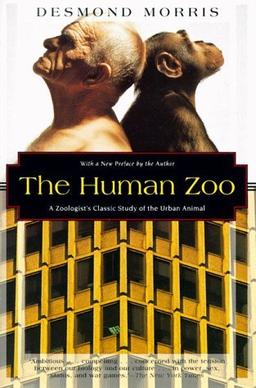
The Human Zoo is a book written by the British zoologist Desmond Morris, published in 1969. It is a follow-up to his earlier book The Naked Ape; both books examine how the biological nature of the human species has shaped the character of the cultures of the contemporary world.

The Naked Ape: A Zoologist's Study of the Human Animal is a 1967 book by English zoologist and ethologist Desmond Morris that looks at humans as a species and compares them to other animals. The Human Zoo, a follow-up book by Morris that examined the behaviour of people in cities, was published in 1969.
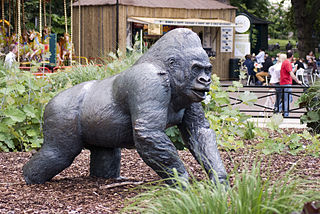
Guy the Gorilla (1946–1978) was a western lowland gorilla who was London Zoo's most famous resident and often profiled on children's TV shows and natural history productions. The exact day of Guy's birth was unknown, but the official birthday was set by the Zoo as May 30, and he received large numbers of cards each year.
The Birmingham Surrealists were an informal grouping of artists and intellectuals associated with the Surrealist movement in art, based in Birmingham, England from the 1930s to the 1950s.
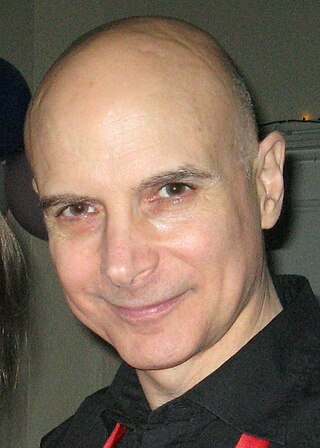
Silvano Levy is an academic specializing in surrealism. He has published on Belgian surrealism with studies on René Magritte, E.L.T. Mesens and Paul Nougé. His research on The Surrealist Group in England began with a film on Conroy Maddox and the book Conroy Maddox: Surreal Enigmas (1995), while a wider interest in the movement led to the editorship of Surrealism: Surrealist Visuality (1997). Levy has curated national touring exhibitions of the work of Maddox and Desmond Morris, and has published a monograph on the latter entitled Desmond Morris: 50 Years of Surrealism (1997), which was followed by the enlarged re-edition Desmond Morris: Naked Surrealism (1999). Subsequent books on Morris include Lines of Thought: The Drawings of Desmond Morris (2008) and three volumes of an analytical catalogue raisonné spanning eight decades. Silvano Levy's monograph on Maddox, The Scandalous Eye. The Surrealism of Conroy Maddox, was published by Liverpool University Press in 2003. The year 2015 saw the publication of Decoding Magritte. Further studies cover Sheila Legge, Dalla Husband, Toni del Renzio, André Breton, Dina Lenković, Jean-Martin Charcot, Mary Wykeham and Birmingham surrealism. Dr Levy is editor of Surrealist Bulletin and has held academic posts at the University of Liverpool, Newcastle Polytechnic, the University of Bath, the University of Hull and Keele University, where he was promoted to Senior Lecturer in French in 1998 and then to Reader in 2005.
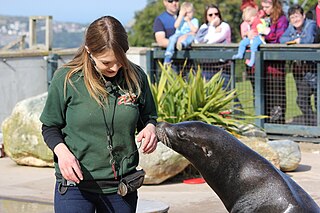
A zoo is a facility in which animals are kept within enclosures for public exhibition and often bred for conservation purposes.
Oscar Mellor was an English surrealist artist and photographer. An associate of the Birmingham Surrealists in the 1940s, he founded the Fantasy Press after his move to Oxford in 1948, publishing works by university poets who emerged into prominence during the 1960s. Although best remembered for the latter, he saw himself primarily as an artist whose business activities existed to support his painting.
Barrington Lionel "Barry" Driscoll was a British painter, wildlife artist and sculptor. Starting as a book illustrator, he specialized in animal subjects and established an international reputation as a wildlife artist.

Chi Chi was a well-known female giant panda at London Zoo in England.

Sir Richard Owen was an English biologist, comparative anatomist and palaeontologist. Owen is generally considered to have been an outstanding naturalist with a remarkable gift for interpreting fossils.
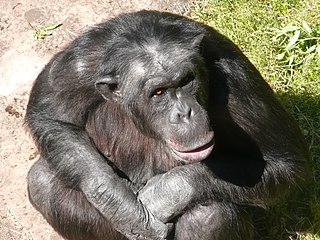
Santino was a male chimpanzee held at Furuvik Zoo in Sweden. In March 2009, it was reported that Santino had planned hundreds of stone-throwing attacks on visitors to the zoo. Santino was shot after escaping his enclosure in December 2022, and later died from his injuries.

The Human Animal: A Personal View of the Human Species is a British nature documentary series written and presented by English zoologist Desmond Morris, first transmitted on BBC One in the United Kingdom from 27 July to 31 August 1994. It was co-produced in association with Discovery Communications in the United States, as well as several public broadcasters include: ORF in Austria, various ARD networks in Germany, and Teleac in the Netherlands.
Reaktion Books is an independent book publisher based in Islington, London, England. It was founded in 1985 in Edinburgh, Scotland, and moved to London in 1987. Reaktion originally focused on the fields of art, architecture, and design. In recent years it has broadened to include more areas and also publishes series of books.
















